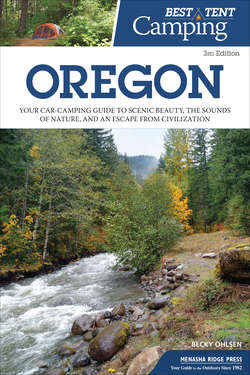Читать книгу Best Tent Camping: Oregon - Becky Ohlsen - Страница 20
На сайте Литреса книга снята с продажи.
Оглавление4
Saddle Mountain State Natural Area Campground
Beauty Privacy Spaciousness Quiet Security Cleanliness
In early to mid-June, the alpine wildflowers here put on one of the most colorful shows in the region.
KEY INFORMATION
CONTACT: 503-368-5943, oregonstateparks.org
OPEN: April–October
SITES: 10
WHEELCHAIR ACCESS: Not designated
EACH SITE HAS: Picnic table, fire ring, piped water
ASSIGNMENT: First come, first served
REGISTRATION: Self-registration on-site
AMENITIES: Flush toilets (restrooms have running water), firewood, day-use area has picnic tables
PARKING: In parking lot at campground; $7/additional vehicle
FEE: $11
ELEVATION: 1,650'
RESTRICTIONS:
PETS: On leash only
QUIET HOURS: None specified
FIRES: In fire rings only
ALCOHOL: Permitted
OTHER: RVs must park in parking lot; 14-day stay limit
Want to enjoy the beach, see the mountains, and not get trampled by the crowds? Or is it one of those sweltering August days when the city feels like a sauna? Saddle Mountain is the answer. This cool green oasis is right on the way to the coast, but it’s close enough to Portland to be reachable on a last-minute trip with minimal planning.
Many people hurrying along US 26 between Portland and the ocean beaches in northwestern Oregon drive right past this spot, either because they don’t know about it or they’re overly focused on the coast as a target.
Don’t get us wrong: the Oregon coast is fabulous. If you can afford it, there are scads of wonderful places to stay—for a day, a weekend, or a week. And there are still plenty of areas that have been preserved in an undeveloped state to showcase the natural coastal beauty—we’ve included some great campgrounds in this very book. But if your interest is tent camping in the purest sense—as in not another soul for miles, just you and the s’mores and the stars overhead—the Oregon coast has somewhat limited options. You’ll find more possibilities for optimum peace and quiet by going farther inland to places such as Saddle Mountain State Park.
Saddle Mountain gives you the best of both worlds: high peaks and expansive beaches within easy reach.
Saddle Mountain gives you the best of both worlds: it’s less than 15 miles from the nearest coastal attractions of Cannon Beach and Seaside, well away from the crowded US 101 corridor, and only a 2.6-mile hike from superb views from atop the park’s namesake, the highest peak in northwestern Oregon. Not a bad combination, really.
Add to that a campground (albeit primitive) for tent campers only and nearly 3,000 acres (roughly 5 square miles) of second-growth forests, fragile meadows, and clear-running creeks. You’ll share the terrain with a number of woodland critters (elk have been spotted in sizable herds within the park) and a host of indigenous plant life (more than 300 species have been identified), some that for reasons not altogether clear have chosen Saddle Mountain as their preferred habitat, growing only here and nowhere else in the Oregon Coast Range.
This latter feature will be of particular interest to the weekend botanist. Saddle Mountain was a haven for certain species of plant life during the Ice Age, and much of that flora evolved in ways peculiar to the Coast Range. Today, high on the flanks of this 3,283-foot peak, plants that are not found anywhere else in the world grow. Saddle Mountain bittercress is one of these unique plants, found only on Saddle Mountain and nearby Onion Mountain. The best time to visit Saddle Mountain is early to mid-June, when the alpine wildflowers put on one of the most colorful shows in the region.
For the weekend mountaineer, Saddle Mountain Trail is a pleasantly surprising challenge, with a reward of unending views from the summit. Casual hikers will probably want to stop at the saddle just beyond the wildflower fields. The more adventurous and sure-footed in your party can continue on to the crest, but be forewarned that the path is steep and indistinct in places, making travel, as the park brochure says, “extremely treacherous” and not recommended for those who aren’t in the best of shape.
Those who do make it to the top can feast on the views while enjoying a picnic lunch. To the south are Nehalem Bay and a sprinkle of small, characteristic coastal towns. Looking west, the Pacific Ocean paints a blue-green backdrop to the resort towns of Seaside and Cannon Beach, with Tillamook Head and Haystack Rock figuring prominently between them. Northward is historic Astoria, where the Columbia River meets the Pacific Ocean. Fort Clatsop is the site of Lewis and Clark’s winter camp in 1805 and 1806. Snowcapped Cascade Mountain peaks to the east add a finishing touch.
The weather is not always conducive to uninterrupted vistas—or even a human presence—on the slopes of Saddle Mountain and can easily change for the worse between the time you leave your campsite and the time you finish the round-trip hike of less than 7 miles. Because the campground and the summit have an elevation differential of more than 2,000 feet, the temperature is often much warmer at the campground than at the summit, so keep that in mind as you pack. Ocean breezes can also have a chilling effect, even if the sun is bright. And in the fiercest conditions, the maritime Pacific climate has been known to dump upwards of 100 inches of rain annually, so be prepared for wet conditions anytime.
GETTING THERE
From I-405 in Portland, take Exit 1D and head west on US 26. Go 63.4 miles to Seaside, and turn right onto Saddle Mountain State Park Road (the turn is just less than a mile east of the intersection of US 26 and OR 53, also known as Necanicum Junction). Drive 7 miles to the campground. A picnic area, parking lot (self-contained RVs can park here), and the trailhead are all located here as well.
GPS COORDINATES: N45º 57.765' W123º 41.400'
